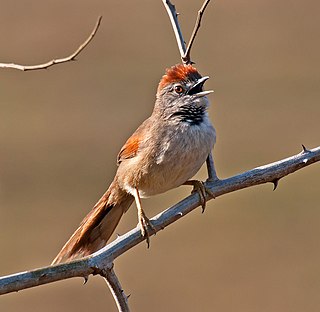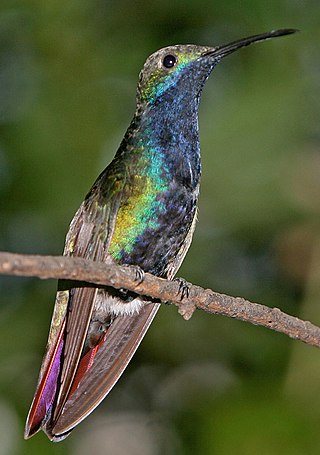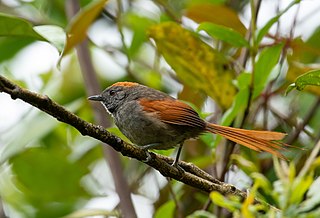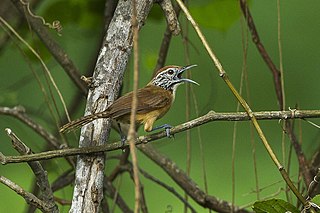
The pale-breasted spinetail is a passerine bird in the Furnariinae subfamily of the ovenbird family Furnariidae. It is found in Costa Rica, Panama, Trinidad, and in every mainland South American country except Chile and Ecuador.

The black-throated mango is a species in subfamily Polytminae of the hummingbird family Trochilidae. It is found in Panama, in every mainland South American country except Chile, and in Trinidad and Tobago.

The golden-olive woodpecker is a species of bird in the subfamily Picinae of the woodpecker family Picidae. It is found from Mexico south and east through Panama, in every mainland South American country except Chile, Paraguay, and Uruguay, and Trinidad and Tobago.

The barred antshrike is a passerine bird in subfamily Thamnophilinae of family Thamnophilidae, the "typical antbirds". It is found in the Neotropics in Mexico, every country in Central America, Trinidad and Tobago, and every mainland South American country except Chile and Uruguay. There is also one accepted record from southern Texas.

The stripe-breasted spinetail is a passerine bird in the Furnariinae subfamily of the ovenbird family Furnariidae. It is found in Colombia, Trinidad, Tobago, and Venezuela.

The streaked tuftedcheek is a passerine bird in the Furnariinae subfamily of the ovenbird family Furnariidae. It is found in Bolivia, Colombia, Ecuador, Peru, and Venezuela.

The rufous-and-white wren is a small songbird of the wren family. It is a resident breeding species from southwesternmost Mexico to northern Colombia and northwestern Venezuela. It was formerly placed in the genus Thryothorus.

Azara's spinetail is a species of bird in the Furnariinae subfamily of the ovenbird family Furnariidae. It is found in Argentina, Bolivia, Colombia, Ecuador, Peru, and Venezuela.

The Inca wren is a species of bird in the family Troglodytidae. It is endemic to Peru.

The plain-tailed wren is a species of songbird in the family Troglodytidae. It has a mostly rufous body with a gray, black, and white striped head. It is found in the Andes of southern Colombia, Ecuador, and northern Peru. Its natural habitat is subtropical or tropical moist montane forests. Plain-tailed wrens are so-called bamboo specialists and live almost exclusively in chusquea bamboo thickets. Like other wrens, its diet consists mainly of insects with some seeds and berries.

The happy wren is a species of bird in the family Troglodytidae. It is endemic to the Pacific slope of western Mexico, from the state of Sonora to the state of Oaxaca, and also on islands west of the Mexican coast. As with other species of Pheugopedius, older sources classify it within genus Thryothorus. Some authorities have treated it as a subspecies of P. rutilus or P. sclateri. There is significant geographical variation, and six subspecies are recognized: P. f. sonorae is found in southern Sonora and northern Sinaloa; P. f. pallidus is found in central Sinaloa, western Durango and southwards to Jalisco and Michoacán; P. f. lawrencii and P. f. magdalenae are found on different islands of the Islas Marías; P. f. grandis is found in the Balsas River basin, and the nominate subspecies, P. f. felix in southwestern Mexico from Jalisco to Oaxaca.

The moustached wren is a species of bird in the family Troglodytidae. It is found in Bolivia, Brazil, and Peru.

The spot-breasted wren is a species of bird in the family Troglodytidae. It is found in Belize, Costa Rica, El Salvador, Guatemala, Honduras, Mexico, and Nicaragua.

The whiskered wren is a species of bird in the family Troglodytidae. It is found in Colombia, Ecuador, and Venezuela.

The speckle-breasted wren is a species of bird in the family Troglodytidae. It is found in Colombia, Ecuador, and Peru.

The sooty-headed wren is a species of bird in the family Troglodytidae. It is found in Colombia and Panama.

The mountain wren is a species of bird in the family Troglodytidae. It is found in the Andes of northwestern Argentina, Bolivia, Colombia, Ecuador, Peru, and western Venezuela.

The straight-billed woodcreeper is a species of bird in the subfamily Dendrocolaptinae of the ovenbird family Furnariidae. It is found in Panama, on Trindad, and in every mainland South American country except Chile, Argentina, Paraguay and Uruguay.

The olive-backed woodcreeper is a species of bird in the subfamily Dendrocolaptinae of the ovenbird family Furnariidae. It is found in Bolivia, Colombia, Ecuador, Peru, and Venezuela.

Pheugopedius is a genus of wrens in the family Troglodytidae that are found in Central and South America.






















